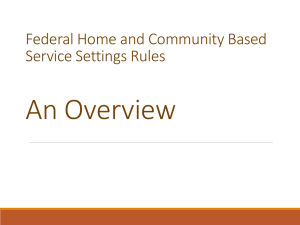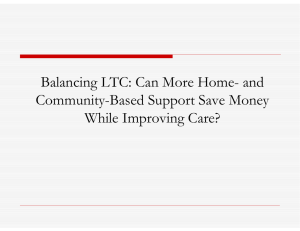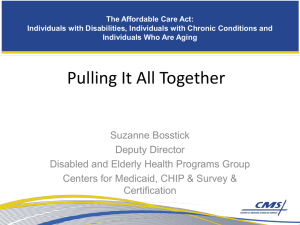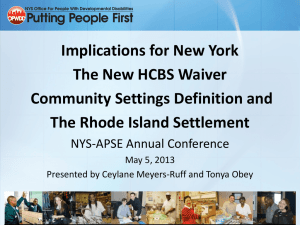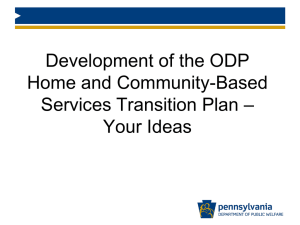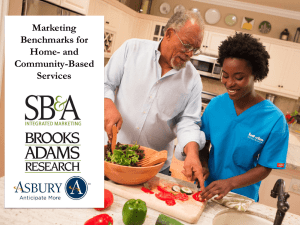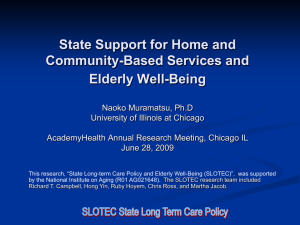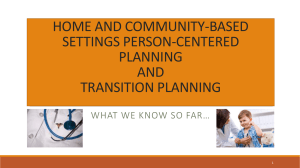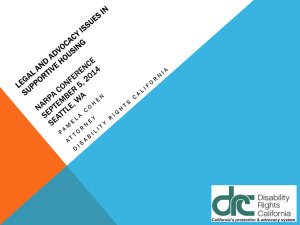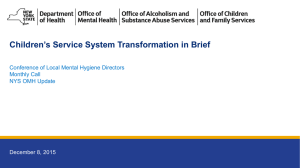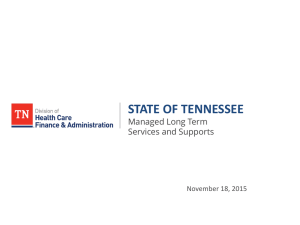Slides - National Long-Term Care Ombudsman Resource Center.
advertisement
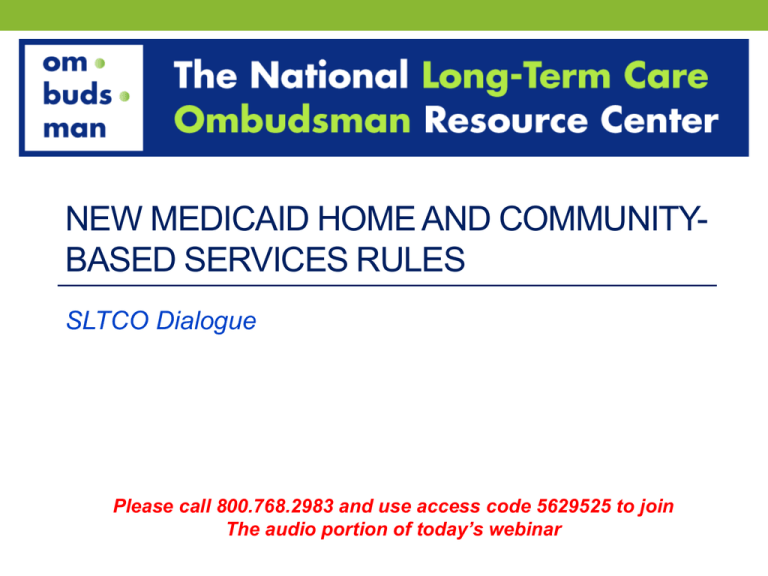
NEW MEDICAID HOME AND COMMUNITYBASED SERVICES RULES SLTCO Dialogue Please call 800.768.2983 and use access code 5629525 to join The audio portion of today’s webinar May 28, 2014 New Medicaid Home and Community-Based Services Rules Eric Carlson www.NSCLC.org 2 The National Senior Citizens Law Center is a non-profit organization whose principal mission is to protect the rights of low-income older adults. Through advocacy, litigation, and the education and counseling of local advocates, we seek to ensure the health and economic security of those with limited income and resources, and access to the courts for all. For more information, visit our Web site at www.NSCLC.org. Intent: Ensure that HCBS Truly Is Provided in Community • Creates first-ever federal HCBS standards. • Rule went into effect March 17, 2014. • Applies to: HCBS waivers • Section 1915 (c) waivers State-plan HCBS programs • Section 1915 (i) programs Community-First Choice Option • Section 1915(k) programs 4 Rules Cover Residential and NonResidential Settings • CMS will issue guidance regarding application of rules to non-residential settings (e.g., day care centers). 5 STANDARDS FOR ALL HCBS SETTINGS 6 Core Standards Applying to All Types of HCBS Settings • Integration with Community – Setting must support full access by the consumer to the community. • Choice – Choice among setting options. • Rights – Rights to privacy, dignity, respect, and freedom from coercion and restraint. • Independence – Setting must optimize ability to make life choices and must facilitate choice regarding services and supports. 7 Exploratory Questions Help Guide Interpretation • CMS: “Exploratory Questions to Assist States in Assessment of Residential Settings” – Integration: Do the individuals in the setting have access to public transportation? – Choice: Can the individual identify other providers who render services? – Rights: Are schedules of individuals for PT, OT, medications, diet, etc., posted in a public area for all to view? – Dignity: Does the staff talk to other staff about an individual as if the individual was not present or within earshot of other people in the setting? 8 STANDARDS FOR RESIDENTIAL CARE FACILITIES www.NSCLC.org 9 Provider-Controlled Residential Settings, i.e., LTC Facilities • Additional standards must be met: – Protection from eviction – Privacy rights – Freedom of choice – Right to receive visitors – Physical accessibility 10 Protection Against Eviction • Lease or other written agreement for specific living unit. • Protections against eviction at least as strong as state landlord-tenant law. 11 Privacy Rights • Lockable entrance doors. • Keys held by “appropriate staff.” • Choice of roommates (where applicable). – Consumer can choose private occupancy, but choice can be restricted by financial consideration, such as Medicaid’s income allocation. 12 Freedom of Choice • Furnish and decorate unit. • Control schedule and activities. • Access to food at any time. – 24 hours a day – More than just snacks 13 Right to Accept Visitors • Any visitor the consumer chooses. • Any time of day, including overnight. – Within limits of lease, to prevent situation where “visitor” essentially moves in. 14 Modification of Rights in Service Plan • Must first attempt alternative strategies. • Specific assessed need must be included in service plan. • Informed consent of consumer. • Periodic review to determine if modification still necessary. 15 QUALIFICATION AS AN HCBS SETTING 16 Institutions Disqualified • • • • Nursing facilities Hospitals Institutions for mental diseases Intermediate care facilities for persons with intellectual disabilities 17 Also Disqualified: Locations with Qualities of Institutional Setting • Presumed to have institutional qualities if: – In building with facility providing inpatient institutional. – On the grounds of, or adjacent to public institution. – “[A]ny other setting that has the effect of isolating individuals receiving Medicaid HCBS from the broader community of individuals not receiving Medicaid HCBS.” 18 What Happens When a Setting Is “Presumed” Institutional? 1) Sunny Bridge Senior Living 2) CMS 3) State 4) CMS is located immediately adjacent to a state hospital. presumes the setting is institutional-has the effect of isolating individuals receiving Medicaid HCBS. Seeks to have setting treated as an HCBS setting; provides evidence that setting is community-based in transition plan. Applies heightened scrutiny in review of evidence from State and stakeholders to make determination about setting. 19 HCBS Payment Can Most Likely Be Made for CCRCs • CCRC – Includes independent living units, assisted living and an nursing home. • CMS: the isolation risk in CCRCs is limited “since CCRCs typically include residents who live independently in addition to those who receive HCBS.” 20 Disqualification of Non-Residential Settings • CMS will issue further guidance. • Non-residential HCBS provider may be disqualified if consumer’s residence is out of compliance with the HCBS setting regulations, even if HCBS is not provided at the residence. 21 STATE TRANSITION PROCESS 22 Transition Process Differs Depending on State 23 Stakeholders Encouraged to Be Involved Throughout Transition Development 24 Now Is Time for Stakeholder Engagement • Key points where STATE should hear from STAKEHOLDERS: – Assessment: Feedback to state as it develops process to ensure compliance with HCB setting requirements. – Transition Plan: Commenting to state on draft plan detailing transition process. – Heightened Scrutiny: Providing evidence to CMS as the agency applies heightened scrutiny to settings. 25 This Is an Important Year in Multi-Year Process • CMS will approve transition plans of up to five years. – Length of transition period depends on different state circumstances. • CMS expects states to transition to new settings requirements in as brief a period as possible. 26 UNANSWERED QUESTIONS, AND ISSUES FOR ADVOCACY 27 Residential Standards Applying to Residents Regardless of Payment Source • Regulations generally referring to “individual” or “individuals.” • Provision pertaining to written lease-type agreements applies specifically to “each HCBS participant.” 28 Why Facility-Wide Application of Standards Makes Sense • Would a non-institutional setting discriminate by payment source? – e.g., Access to food at any time. – Right to receive visitors. – Lockable doors. 29 How Will Rules Be Enforced? • To great extent, no existing mechanism. – State makes assurances to CMS regarding beneficiaries’ health and welfare. • For residential care facilities, state often references existing state licensure standards. 30 Many Questions to Be Answered Re: Enforcement • Consumers will need some enforcement mechanism to make these standards a reality. • Thoughtful, persistent advocacy will be required. 31 Other Issues/Questions Presenting Themselves • Does transition plan address the substance, or just the process for developing a plan? – See, e.g., Iowa, Wyoming • How to arrange compliance for Demonstration Waivers and Community First Choice Option 32 Questions? Eric Carlson ecarlson@nsclc.org (213) 674-2813 33 ROBYN GRANT Director of Public Policy and Advocacy, National Consumer Voice for Quality LongTerm Care Please call 800.768.2983 and use access code 5629525 to join The audio portion of today’s webinar BECKY KURTZ Director, Office of LTCO Programs with AoA of ACL Please call 800.768.2983 and use access code 5629525 to join The audio portion of today’s webinar ELIZABETH PRIAULX Senior Disability Legal Specialist, National Disability Rights Network (NDRN) •Advocacy Checklist: http://hcbsadvocacy.files.wordpress.com/2014/05/hcbs _advocates_checklist1.pdf •HCBS Advocacy Information: http://hcbsadvocacy.org/ SLTCO OPEN DIALOGUE Please call 800.768.2983 and use access code 5629525 to join The audio portion of today’s webinar The National Long-Term Care Ombudsman Resource Center (NORC) www.ltcombudsman.org The National Consumer Voice for Quality Long-Term Care (formerly NCCNHR) http://www.theconsumervoice.org/ This presentation was supported, in part, by a grant from the Administration on Aging, Administration for Community Living, U.S. Department of Health and Human Services.
